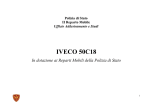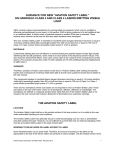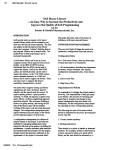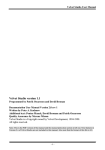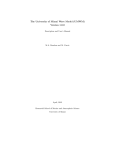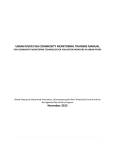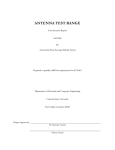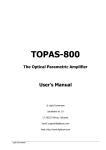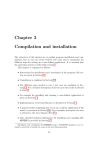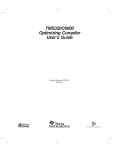Download User`s Manual for NEARCOM Diffractive, Unsteady Wave Driver DUNS
Transcript
User’s Manual for NEARCOM Diffractive, Unsteady Wave Driver DUNS Andrew B. Kennedy Department of Civil and Coastal Engineering University of Florida, Gainesville, FL 32611-6590 USA. [email protected] & James T. Kirby Center for Applied Coastal Research University of Delaware, Newark, DE 19716 USA. [email protected] 1 1 Summary This manual gives a brief description of the diffractive, unsteady wave driver DUNS for the NEARCOM model suite. Examples and sample setups are included. The model can predict leading order time-varying, multidirectional, and diffractive behaviour and is thus expected to be useful for the study of wave group forcing on nearshore hydrodynamics. Leading order, but not full, wave-current interaction is included. Because of assumptions in the derivation and choices made in coding, the model is meant for use on open beaches where there is a clear longshore and cross-shore direction. It should not be used in areas with strongly curved shorelines or in areas with strong diffraction, such as inside a harbor. 2 2 Introduction Waves in the ocean are universally acknowledged to be unsteady and multidirectional. As they pass from deep water into finite depths and through to the shoreline, these variations in shoaling and breaking wave heights and directions will also cause spatial and temporal variations in low frequency waves and currents. Despite this, the majority of numerical modelling efforts have used either monochromatic or spectral models, neither of which includes the effects of wave groups. In this manual, we describe a numerical wave driver, DUNS, that can describe the time-varying wave climate in the nearshore on the scale of wave groups. The model operates in the time domain and includes leading order multidirectionality, diffraction, and wave-current interaction. The basic formulation is from Kennedy and Kirby (2003), and comes from a nonlinear, multiple scale perturbation expansion. Multidirectionality and diffraction are accounted for by making the wave amplitude, A, complex with both real and imaginary components. This leading order multidirectionality is accurate to approximately ±30 degrees from a central direction, and diffractive frequency dispersion to perhaps ±15% from a peak frequency. Accuracy degrades continuously from this peak direction and frequency, but is quite accurate near the peak. 2.1 Numerical Setup All waves are generated at the offshore boundary as seen in Figure 1. Offshore waves may have any mean angle where the waves travel into the domain rather than out of the domain - this is to say that the waves must travel somewhat in the positive x-direction rather than the negative x-direction. The driver has an unstaggered grid and is second order in space and fourth order in time. Differences are centered in space. The main evolution equation solved by the driver is: " 2At + 2(C̄g ) · ∇A + σ̄∇ · C̄g −i ∇2 A + i κ̄ C̄g − σ̄κ̄κ̄ κ̄ ! C̄g σ̄ ! # 1 − σ̄t A − 2iA C̄g (κ − κ̄) + κ̂ · Ū σ̄ Axx k̄ 2 + 2Axy k̄ l̄ + Ayy l̄2 κ¯2 ! + iσ̄κ̄2 β|A2 |A +2w = 0 (1) where κ̄ is the regularised bathymetry, and κ̂ ≡ (κ − κ̄)(cos θ, sin θ) is the difference between the actual and regularised wavenumbers multiplied by the wave direction vector. The regularised wavenumber k̄ is taken from the regularised depth h̄. This is defined as any depth field for which the underlying wavenumber vector field has no caustics: many topographies with submerged shoals will not have well behaved refraction fields, so a regularised bathymetry 3 Onshore boundary ==> y Offshore boundary Lateral boundary 0 ==> x Lateral boundary Figure 1: Definition sketch for wave propagation showing boundaries and sample wavenumbers in the domain. is defined with acceptable refraction. The regularised wavenumber vector field satisfies the linear dispersion relation σ 2 = gκ̄ tanh κ̄h̄ (2) and the eikonal wavenumber condition ∇ × (κ̄(cos θ, sin θ)) = 0. The difference between the regularised and actual bathymetries drives diffractive terms which approximate the effects of the actual bathymetry. This approach has been known for some time and is used in well known models such as REF/DIF1. In DUNS, the regularised bathymetry is computed at each x-location as the longshore average (in y) of the depth. This is the main reason that restricts DUNS to open beaches, and is a coding choice, not a theoretical restriction. Considerably more complex choices could be used as long as they satisfy the eikonal wavenumber relations, but would require some recoding. The closer the regularised bathymetry is to the actual bathymetry, the more accurate the program becomes. The group velocity Cg ≡ ∂σ/∂κ and the diffractive coefficient σ κ̄κ̄ and nonlinear dispersion coefficient β are defined in Kennedy and Kirby (2003). Wave dissipation is represented in equation (1) by w and is taken as that of Roelvink (1993), 4 but would be simple to change to any other desired formulation. The program is written in mainly standard fortran77, but on some compilers you will need to compile it as a f90 code because of non-standard extensions. Sample compiler commands are included in section 4.5. Memory requirements are not large and it can be run easily on any modern PC. Because DUNS operates in the time domain, it is different from most of the wave drivers that operate with NEARCOM. The majority of these provide steady radiation stresses which force the circulation components for a period of minutes to an hour, at which time a new wave climate might be applied. For wave group forcing, this is not at all acceptable. Wave group time scales are generally defined to be of O(20-200s), so to resolve the temporal variation of wave forcing to the circulation model, we must update on time scales much less than this. Typically, we recommend passing information to the circulation model at time scales of O(1-2s) to ensure good resolution. Those with quick eyes will note that this gives the overall model first order accuracy on the time scale of the information passing (1-2s). Because of the modular NEARCOM design, this is unavoidable, but errors introduced here are probably order of magnitude less than errors in estimating, for example, radiation stresses in breaking waves. 3 3.1 Examples Wave focusing on a submerged shoal This is a nonbreaking example that can not be duplicated here because of the wave breaking in the code, but serves to evaluate the accuracy of the basic formulation. The focusing shoal of Berkhoff, Booiy, and Radder (1982) has been used as a test of difraction for many different wave models. Figure 2 shows the bathymetry contours and measurement cross-sections. This topography leads to strong focusing of wave rays, with caustics occurring behind the shoal. Because of this, method 1 may not be used on this topography, as an underlying refraction solution does not exist. However, method 2 is well suited to such a computation. The underlying bathymetry was assumed to be a longshore uniform beach, whose depth was chosen to be the average over the longshore domain. A computational grid size of ∆x = ∆y = 0.25m was used with a time step of ∆t = 0.025s. Lateral boundaries used a reflective condition, which is considerably different than the physical experiment, but as boundaries were far away from the area of interest, this was not a concern. Formally, the physical wave height in computations is not just H = 2|A|, but includes higher order corrections. However, because of the semi-empirical modifications to nonlinear dispersion, with unknown effects on surface profiles, we use this simpler representation. For some situations, 5 25 20 (8) (7) (6) 8 10 12 (5) Distance (m) (4) (3) 15 (2) (1) 10 5 0 0 2 4 6 14 16 18 20 Distance (m) Figure 2: Contours of bathymetry on BBR shoal, showing measurement transects. this approximation would be unacceptably crude; however, for the present case, reasonable results may still be obtained. Figures 3-4 show computed and measured wave heights along the transects. In general, agreement is quite good. Both the trend and the magnitude of the refraction and diffraction caused by the shoal are well represented. The present results look very similar to those computed using the narrow angle parabolic model given in Kirby and Dalrymple (1986). This is not surprising as, with the further assumptions of time invariance, weak diffraction in the direction of propagation, and negligible current, the two models are equivalent. Since none of these effects are likely to be highly significant in this case, the results are very similar. Although the present results are good, it is possible to achieve slightly greater accuracy by using full time-domain systems such as Boussinesq models (e.g., Wei et al., 1995). This is because these models do not assume an underlying form for the wave, and thus can represent better the strong nonlinear diffraction. Still, Boussinesq models are computationally an order of magnitude slower than the present model, and thus cannot be easily used for long time scales in field situations. Wide-angle parabolic models can also produce slightly better results in this case (e.g. Kirby, 1986), as their treatment of diffraction is more accurate. This improvement in accuracy is mainly 6 (1) H/H0 2 1 0 5 6 7 8 9 10 11 12 13 14 15 6 7 8 9 10 11 12 13 14 15 6 7 8 9 10 11 12 13 14 15 6 7 8 9 10 11 12 13 14 15 6 7 8 9 10 11 12 13 14 15 (2) H/H0 2 1 0 5 (3) H/H0 2 1 0 5 (4) H/H0 2 1 0 5 (5) H/H0 2 1 0 5 y (m) Figure 3: Computed (-) and measured (x) wave heights at transects 1-5 on BBR shoal seen in the side lobes of longshore transects 4-5, where the wide-angle approximation allows for more accurate diffraction far from the mean wave direction. Overall, however, agreement is quite good using the present model, and gives confidence that accurate refraction/diffraction/shoaling results can be obtained in situations for which no direct confirmation is available. 3.2 Longshore Current with Unsteady Wave Forcing DUNS is well suited to examine longshore currents in the presence of unsteady wave forcing. Here, it is used to force the quasi-3D circulation model SHORECIRC (Svendsen et al., 2002). Figure 5 shows the longshore-uniform bathymetry, which has a bar-trough topography. This example is found in the download package. All input files for both DUNS, SHORECIRC, and NEARCOM are included. A dummy sediment module is used. SHORECIRC here is used in 2D mode, as there are unresolved feedback issues between DUNS and the 3D SHORECIRC flow. The example is a little contrived, with only 5 frequency components used, so that users may see easily how the program works and may also modify it easily. Still, it shows many of the principles and methods required for more complex examples. The program runs for 1200 s, with 7 2.5 (6) H/H0 2 1.5 1 0.5 0 0 1 2 3 4 5 6 7 8 9 10 11 1 2 3 4 5 6 7 8 9 10 11 1 2 3 4 5 6 7 8 9 10 11 2.5 (7) H/H0 2 1.5 1 0.5 0 0 2.5 (8) H/H0 2 1.5 1 0.5 0 0 x (m) Figure 4: Computed (-) and measured (x) wave heights at transects 6-8 on BBR shoal both SHORECIRC and DUNS providing output. We will not worry about the SHORECIRC output as DUNS output provides everything we need. First, compile and run helper program, ‘fgen.f’. This produces the input file ‘freqs.dat’ from the original file spec.dat’. Next, compile the master program. A compile command that works on many PC compilers is f90 master.f sed.f duns.f winc*.f Any optimization switches desired may be used. Next, run the master program. There must be a subdirectory ‘data’ in the target directory as the program will write output here. After the master program has finished, the Matlab code ‘readata.m’ will compute and plot the mean current and vorticity averaged from 800-1200s. Results are shown in figures 6-7. Note that the 400s averaging period has still not removed all longshore variation in vorticity because of a combination of the shear waves and unsteady forcing. 8 Elevation (m) 0 −2 −4 −6 0 50 100 150 200 250 x (m) Figure 5: Barred bathymetry for test case. 4 Inputs and Outputs In addition to data passed from the master program, there are two major input files required by DUNS. One gives general computational details, while the second details input wave parameters. 4.1 Input File ‘winput.dat’ The input file ‘winput.dat’ provides the grid sizes, time step, and boundary conditions for the wave driver. A sample file is 3.0 10 0.25 3 15 1 1 ! cdx ! cdy ! cdt ! mbcy ! ncallskip ! I_hard ! Ang_use The first two entries are the x and y grid sizes, cdx and cdy. Theoretically, these could be taken from the master grid, but we find it useful to make them explicit. The next quantity is the model time step. The next is the lateral boundary condition: for a periodic boundary, set to mbcy=3, while for a lateral wall boundary condition on both sides, set to mbcy=1. We note very strongly that the size of the domain will be different for wall or periodic boundary conditions: for a periodic lateral domain, the size is ny ∗ dy (as in a discrete Fourier series), while for a wall domain, the size is (ny − 1) ∗ dy (because the first and last grid points are exactly at the walls in an unstaggered grid). 9 1.2 1 U, V (m/s) 0.8 0.6 0.4 0.2 0 −0.2 0 50 100 150 200 250 x (m) Figure 6: Longshore and cross-shore velocities averaged in the longshore over 400s. The next entry is the output interval. The driver will output files every ncallskip times it is called by the master program, i.e. after the ncallskipth call, 2 ∗ ncallskipth call, etc. The entry after this defines the record length for the binary output, and may differ between computers. For PCs, this should be set to ‘1’, while with some unix compilers, it should be set to ‘4’. The final entry chooses the method of calculating angles. This actually has no effect on the wave computations, but will influence radiation stresses output to other programs. Using ‘1’ will use the angle of the underlying wavenumber, while ‘2’ attempts to include diffractive effects on the computation of the angle. If multidirectional or diffractive effects are important in your computation, you should use ‘2’ here, but it is somewhat less stable that the simple method. 4.2 Input Files ‘freqs.dat’ and ‘spec.dat’, and helper program ‘fgen.f ’ The input file ‘freqs.dat’ and ‘spec.dat’ define the input wave climate. The helper program ‘fgen.f’ is used to convert the more user-friendly input ‘spec.dat’ into the DUNS input file ‘freqs.dat’. The input file ‘spec.dat’ looks like 9300, 22332, 49992, 32244 10 900 800 700 y (m) 600 500 400 300 200 100 0 0 50 100 150 200 x (m) Figure 7: Vorticity averaged over 400s. Note the presence of shear waves is still noticeable because of the relatively short averaging period. 8 6.0 0.15 0.0 10.0 0.1425 0.4 10.0 0.141 0.15 8.0 0.159 0.15 13.0 0.1308 0.15 20.0 0.1712 0.15 7.0 0.155 0.15 10 0.165 0.15 0 The first four entries are seeds for a random number generator used to generate phases for each component. They may be changed as desired. The next entry is the number of frequency components to be used. (The maximum number of entries is governed by ‘maxfreq’ in ‘p1.h’, and is initially set to 501. This can be changed if desired.) The line after this is the depth at which these will be generated (depth at offshore boundary). Each of the next lines contains data about each of the unsteady components. The first number on each line is the frequency in Hz. The second is the amplitude of each component in m. The third is the orientation of each component 11 relative to the x-axis in degrees (0 is exactly oriented with the x-axis). This is quite simple, but there are several subtleties: • The first component encountered in the file will be taken to provide the central frequency and direction. Note that by giving it zero amplitude here, we can define it without messing up any other ordering scheme for frequencies we may wish to use. • If a wall lateral boundary condition is used, (mbcy=1), all components are set to have zero angle, • The program ‘fgen.f’ assigns a random phase to each component. These are set by the constants at the beginning of the program and can be changed if desired, • For a periodic boundary condition and a given wavelength, there are only a limited number of angles that are physically possible. For an overall longshore domain length of L y0 = ny∗dy the fundamental longshore wavenumber is then k y0 = 2π/Ly0 . Every wave component must then satisfy kj sin θj = mky0 , where kj and θj are the wavenumber and angles of component j, and m is an integer. This is checked in the main program and angles are adjusted to fit properly. Sometimes the jump from one allowable angle to another may be more than might be tolerable: in these cases, it is best to increase the longshore domain length, if possible. 4.3 Output after each wave driver call At the end of each wave driver call when control returns to the master program, DUNS outputs several ascii files that are useful for examining wave output. These are of the form ‘junk?.out’, where ‘?’ is an integer. η, Ū , A, and V̄ correspond to ? = 1 − 4. The format of the output is 100 open(1,file=’junk1.out’) do i = 1, nx write(1,100)(etac(i,j),j=1,ny) end do close(1) format(401(f10.4)) These can be loaded directly into Matlab or other programs, or they may be viewed using a text editor. Because they always have the same name, they are overwritten every time the wave driver is called. 12 4.4 Output After Every ncallwave Times the Wave Driver is Called Binary data files are written to the ‘data’ subdirectory every ncallwaveth time the wave driver is called, or every ncallwave ∗ master dt ∗ n interval callwave seconds. These have the form ‘amp00001.out’ and so on where ‘amp’ is replaced by ‘eta’, ‘u’, or ‘v’ for other variables. The files are written using the commands & & & & write(fnames,’(a8,i1,i1,i1,i1,i1,a4)’)’data/amp’, mod(noutskip/10000,10), mod(noutskip/1000,10), mod(noutskip/100,10), mod(noutskip/10,10),mod(noutskip,10),’.out’ open(1,file= fnames, status = ’unknown’, access=’direct’, recl=4*ny) do i = 1, nx write(1,rec=i),(abs(amp(i,j)), j=1,ny) end do close(1) where noutskip = 1, 2, 3, . . . numbers the files sequentially. These files may be read using fortran or Matlab. If different output data is desired, probably the easiest way is to add another output section similar to that above but with the appropriate filename and output variable. For example, to output radiation stress Sxx , c write(fnames,’(a8,i1,i1,i1,i1,i1,a4)’)’data/sxx’, middle lines the same do i = 1, nx write(1,rec=i),(pass_sxx(i,j), j=1,ny) end do close(1) is appropriate. Note that the ‘a8’ on the first line would have to be changed if the filename prefix is not three letters like ‘sxx’. Other possible desired outputs are pass sxy, pass syy, pass theta, pass ubott, pass height, pass cg, pass wavenum, pass theta, pass c, pass massf luxu, pass massf luxv, pass diss, pass wavef y, pass wavef x. Not all of these change with time, so outputting some would be wasteful. 13 4.5 Compilation and Execution A compile command that works on many PC compilers is f90 master.f sed.f duns.f winc*.f where ‘duns.f’ is the DUNS code. Any optimization switches desired may be used. To compile the helper program ‘fgen’, the command f90 fgen.f works. ‘Fgen’ may also be compiled as a fortran77 program. To execute, simply run the ‘master’ program using whatever format is best on the particular system. I find that, on a PC, running in a DOS window is much better, as if the program can’t read input or blows up for any reason, the window doesn’t disappear. On Unix or Linux shells, this should not be a problem. 5 How to get Bad Results These are a few ways in which you can get bad results from the wave driver. 5.1 No ‘data’ subdirectory If you do not have a ‘data’ subdirectory for out put data, you will get an error the first time the program tries to write sequential files. 5.2 Short longshore domain If you have a short longshore domain, the mean angle will not be represented well (because of the finite number of possible angles for a given wavenumber in a finite longshore domain). To fix this, increase domain length. 5.3 Very strong longshore bathymetry variations This program is coded only for mild longshore bathymetry variations. It is difficult to define ‘mild’ exactly, but a good rule of thumb might be that for a constant x, longshore depths should not vary from the mean longshore depth at that location by more than a factor of 2. For very strong longshore variations, you will continue to get results, but these will become increasingly unreliable. 14 5.4 Very wide range of frequencies A good rule of thumb is that frequencies should not vary by more than ±15 − 20% from the underlying frequency. Again, there will be a continual loss of accuracy as frequency bandwidths increase. 5.5 Very wide directional distribution Directions of ±30 degrees from the central direction will not show too much error, but accuracy decreases quickly after this. 5.6 Very strong Currents The model has leading order wave-current interaction, but will not give good representations of waves anywhere near the blocking point. 5.7 Many Input Directions at a Frequency There is a very big difference between a spectral representation, with a directional distribution at a given frequency, and a deterministic representation with many directions per frequency. The difference is that in the spectral representation, all of the different directions are assumed to be uncorrelated. However, with the deterministic representation, all components with the same frequency are perfectly correlated throughout all time. This can cause problems because of spurious high/low areas of breaking waves. To get around this: say you have 10 directions at a given frequency with frequency bandwidth df . Instead, use a bandwidth df /10 and give each component its own unique frequency. Within the assumptions made to arrive at a spectrum, the two are identical, but the second option works much better in a deterministic model. References Berkhoff, J.C.W., Booy, N., and Radder, A.C. (1982). “Verification of numerical wave propagation models for simple harmonic linear water waves”, Coastal Eng., 6, 255-279. Kennedy, A.B., and Kirby, J.T. (2003). ”An unsteady wave driver for narrowbanded waves: modeling nearshore circulation driven by wave groups”, Coastal Eng., 48(4), 257-275. Kirby, J.T. (1986). “Higher-order approximations in the parabolic equation method for water waves”, J. Geophys. Res. 91(C1), 933-952. 15 Kirby, J.T. and Dalrymple (1986). “An approximate model for nonlinear dispersion in monochromatic wave models”, Coastal Eng., 9, 545-561. Roelvink, J.A. (1993). ”Dissipation in random wave groups incident on a beach”, Coastal Eng. , 19(1-2), 127-150. Svendsen, I. A., Haas, K. and Zhao, Q. (2002). “Quasi-3D nearshore circulation model SHORECIRC. Version 2.0”, Research Report CACR-02-01, Center for Applied Coastal Research, University of Delaware, Newark. Wei, G., Kirby, J. T., Grilli, S. T. and Subramanya, R., (1995), “A fully nonlinear Boussinesq model for surface waves. I. Highly nonlinear, unsteady waves”, Journal of Fluid Mechanics, 294, 71-92. 16






















